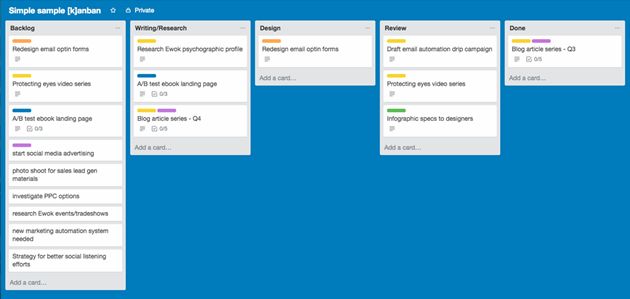We content creators have a tough gig. We're not just responsible for the fun kinds of content—the interesting case studies and the in-depth articles on fascinating topics.
We also have to deal with "Oh, by the way" requests from all over the organization. Our days become a parade of "minor" requests...
"Could you just jump in and film this customer testimonial? It really shouldn't take that long."
"I really need another email in this nurture campaign. Can you just throw one together for me?"
"I forgot about this important client call tomorrow. Would it be too hard for you to compile a case study real-quick?"
It can be tough to push back and remind our colleagues that we aren't short-order content cooks who can whip up content at a moment's notice. Fortunately, there's a work-management process designed to protect the content creators of world.
It's called Agile, and it works beautifully in marketing.
For my fellow content marketers, I want to share four Agile practices that can help insulate you from "Oh by the way" moments. Pick up just a few of these, and you'll be able to produce more work in less time with far less stress.
Agile Practice No. 1: The Content Backlog
The simplest way to think about the backlog is as a prioritized to-do list. It tells the content team what's most important at any given time, so when they're ready to start a new project they know it reflects the department's current priorities.
Though the content backlog is filled with content, not every item it holds will be prioritized equally and conceptualized to the same degree:
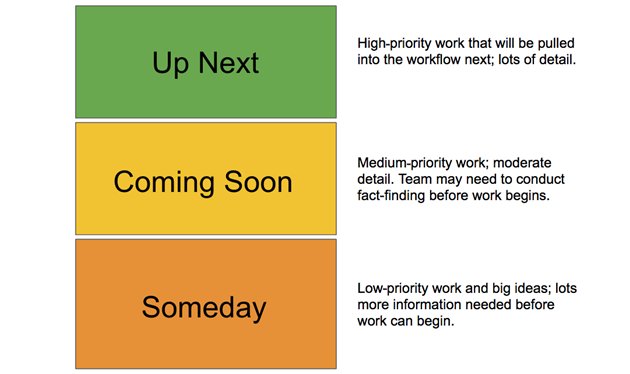
- Items at the top are going to be worked on soon (green in the diagram), which means they need a higher degree of detail and specificity than those at the bottom.
- Pieces at the bottom can be vague, because it may be weeks or months before the content team starts work on them.
A backlog allows you to capture ideas and prioritize them regularly without needing to spend hours hashing out logistics for pieces that won't come up any time soon.
But just because a content item at the bottom of the backlog doesn't require detail now doesn't mean you can throw it in there and then forget about it.
Instead, marketing leadership needs to stay on top of the backlog, ensuring that it's regularly refined and it reflects the team's current priorities.
You'll have the best luck keeping your backlog current if there's a single person in charge of its state, such as a content strategist or director of content. Even if multiple stakeholders get input into what goes into the content backlog, there will ideally be one person who makes sure their ideas are specific, detailed, and important by the time they arrive at the top.
Agile Practice No. 2: Workflow Visualization
Once you've identified the most important work for your content team to tackle, you need to understand what happens during the process of content creation. For that, you need to visualize your workflow.
That may sound complicated, but it can start with a very simple sketch:
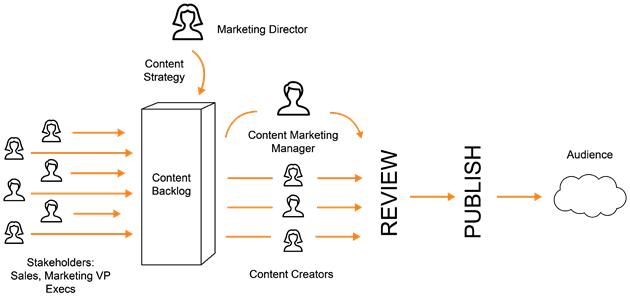
You need to answer three basic questions:
- Where does the work come from?
- What happens to it while it's being worked on in your team?
- Where does it go when you're done with it?
As you're digging into those questions for the first time, make sure you have the content creators themselves in the room.
That's a nice way of saying you can't let managers and directors map out how they think content gets done. You need to ask the people actually doing the work to weigh in on the visualization if it's going to work.
After you get a basic sketch done, you can turn it into a simple kanban board:
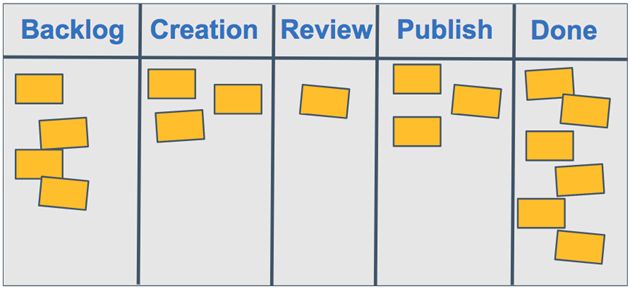
Analog whiteboards, as depicted above, are a great way to get these out in the open really quickly, or you can throw together a simple Trello board:
Each time your content enters a new phase or needs to be handed off to a new person, add a column to your board.
Be specific, but don't go overboard.
If you start getting close to 10 columns, it may be time to consider adding a second board to track different kinds of content. The point of a workflow visualization is to quickly understand how work is flowing (or not flowing) through a team, so if it takes 10 minutes to parse your board, then it's too complex to do its job.
Agile Practice No. 3: WIP Limits
Now we know what work to do next, and we can track it from ideation to completion, so our third tool helps us optimize the content creation process.
Work-in-progress (WIP) limits can seem complicated, but they are one of the most powerful and effective Agile tools available.
Take a few minutes to understand and experiment with them, and you'll forever revolutionize your output.
WIP limits, quite simply, keep content teams from diluting their attention among half a dozen pieces of content. They put strict limitations on how much work we can do at once, which produces two game-changing outcomes:
Content creators stop starting on new pieces and actually finish what they're working on.
More creative energy is poured into each piece because less time and mental effort is lost to the nefarious act of context-switching.
Let's tackle each of those separately so you can fully understand the awesome power of WIP limits.
Stop Starting. Start Finishing.
WIP limits can be applied to each stage of a workflow, which works great for teams of two or more content creators. In those situations, your board might look something like this:
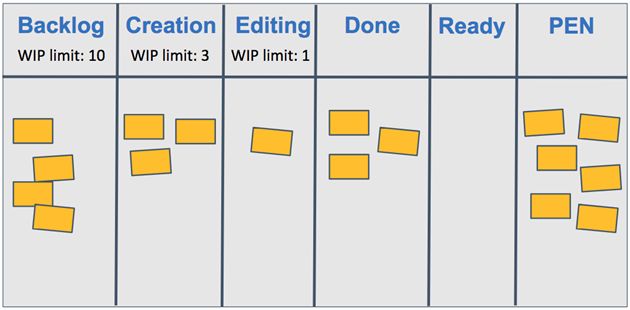
Here, we can't take on any more design work because we're at our WIP limit. If the writers are finished and want to pass work on, they need to do something to help the design team finish what it's working on.
Introducing constraints like this are great for gently enforcing cross-functionality on a team, but their most important role is to force a team to finish what they're already doing before they take on something new.
In other words, they can't start that new infographic until the blog post and email series that are in progress are finished.
WIP limits make sure we're actually getting stuff done.
Down With Context-Switching
In addition to nudging content creators to finish their work, WIP limits drive up the quality of what we're producing by helping to eliminate context-switching.
When we move from task to task or project to project, it takes time and mental energy to change direction. That refocusing time isn't productive; it's wasted time.
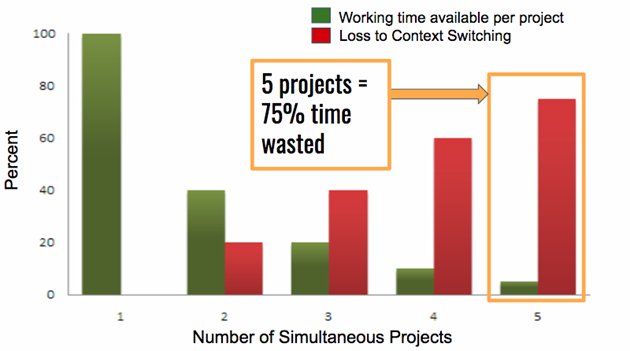
You can see that when we have only one thing in progress at a time, we have 100% of our time to devote to it. But when we're doing five things, we've got only 5% of our time available for each thing.
Fully 75% of time is wasted.
WIP limits put a cap on how much we can do at any given time, which lets us devote ourselves fully to a project and deliver higher-quality work.
Agile Practice No. 4: Content Sprints
Truth time: I'm kind of anti-Scrum and anti-sprint. I think they impose unnecessary stress on marketing teams, and they often cause more problems than they solve.
Nonetheless, they can provide a crucial barrier around content teams.
Sprints are simply timeboxes, or self-imposed deadlines that teams agree to. They look at their collective to-do list (or backlog) and decide how much of it they can do within the next sprint.
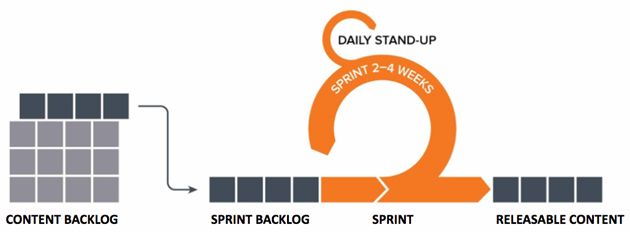
Once they've committed, nobody can add in any more work.
That means content teams, freed from manufactured emergencies and interruptions, can focus on a set amount of work during a sprint.
This protection often more than makes up for some of Scrum's problems for marketing teams, so consider whether short sprints might help the team deliver faster and lose less time to interruptions.
Take an Agile Approach to Going Agile
If these four practices seem like too much to tackle all at once, don't despair. You can pick them up one by one, steadily adopting each one when you're ready.
Think of it as an agile way to be more Agile.
Start with a nice backlog, then visualize your work, add some WIP limits, and finally experiment with sprints. Before you know it, you'll be a lean, mean, Agile content machine.
